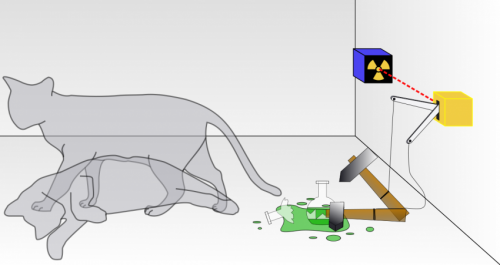Schrödinger's cat: a cat, a flask of poison, and a radioactive source are placed in a sealed box. If an internal monitor detects radioactivity (i.e. a single atom decaying), the flask is shattered, releasing the poison that kills the cat. The Copenhagen interpretation of quantum mechanics implies that after a while, the cat is simultaneously alive and dead. Yet, when one looks in the box, one sees the cat either alive or dead, not both alive and dead. This poses the question of when exactly quantum superposition ends and reality collapses into one possibility or the other. Credit: Wikipedia / CC BY-SA 3.0
(Phys.org) —Impressive things were happening in physics and the sciences in general last week, starting with a radical new theory from physicists at Griffith University—they are proposing the idea of the existence and interaction of parallel worlds—a many interacting worlds theory that is seeking to take the idea from science fiction to hard science. Also a research team at Brown University wants to know if the wave function of an electron be divided and trapped. Experiments they're conducting suggest it might indeed be possible. And physicist Lajos Diósi published a paper describing experiments he conducted that showed that spontaneous wave function collapse can suppress acoustic Schrodinger cat states—he's trying to get in the gap that exists between the physics of the famous cat problem and the reality of the non-existence of real cat states.
In other really big news, China completed its first mission to the moon and back—the probe circled the moon several times taking pictures, then was returned safely to Earth—their long range plan is to send humans there. In other space news, a team of researchers claimed that the universe is older than it looks. Results from testing of the Methuselah star suggest that its upper age limit might lie "this side of the Big Bang."
In other news, researchers at Children's Hospital Oakland Research institute, identified what they believe is a key factor in the relationship between diet, inflammation and cancer—a finding that may lead to progress in preventing cancers related to the GI tract. Also, in an intriguing study, researchers at the Scripps Research Institute have created an enzyme that could help explain the origins of life—they're trying to mimic natural evolution in a test tube—the enzyme might have properties that were uniquely suited for the creation of life. Also, another team of researchers has developed a new method for controlling light scattering, and in so doing have found that a light-matter interaction can turn opaque materials transparent.
And finally, for those people who have felt their chronic fatigue issues have not been taken seriously or been adequately addressed by their physician, comes hopeful news—researchers at Stanford University have found brain abnormalities in chronic fatigue patients. It may not mean a cure is nigh, but it does finally offer proof of something being wrong.
© 2014 Phys.org
























